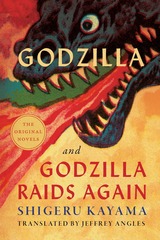
The first English translations of the original novellas about the iconic kaijū Godzilla
Godzilla emerged from the sea to devastate Tokyo in the now-classic 1954 film, produced by Tōhō Studios and directed by Ishirō Honda, creating a global sensation and launching one of the world’s most successful movie and media franchises. Awakened and transformed by nuclear weapons testing, Godzilla serves as a terrifying metaphor for humanity’s shortsighted destructiveness: this was the intent of Shigeru Kayama, the science fiction writer who drafted the 1954 original film and its first sequel and, in 1955, published these novellas.
Although the Godzilla films have been analyzed in detail by cultural historians, film scholars, and generations of fans, Kayama’s two Godzilla novellas—both classics of Japanese young-adult science fiction—have never been available in English. This book finally provides English-speaking fans and critics the original texts with these first-ever English-language translations of Godzilla and Godzilla Raids Again. The novellas reveal valuable insights into Kayama’s vision for the Godzilla story, feature plots that differ from the films, and clearly display the author’s strong antinuclear, proenvironmental convictions.
Kayama’s fiction depicts Godzilla as engaging in guerrilla-style warfare against humanity, which has allowed the destruction of the natural world through its irresponsible, immoral perversion of science. As human activity continues to cause mass extinctions and rapid climatic change, Godzilla provides a fable for the Anthropocene, powerfully reminding us that nature will fight back against humanity’s onslaught in unpredictable and devastating ways.
Retail e-book files for this title are screen-reader friendly.

This first comprehensive history in a Western language of the development of Japanese astronomy has interest beyond its immediate subject area, for astronomy has often been the focus of the transmission of a wide range of scientific ideas from one culture to another, and, concomitantly, the focus of conflict between opposing modes of thought.
In its earlier phases, Japanese astronomy was completely dominated by Chinese concepts. The author begins his study with a description of the three major aspects of Chinese astronomy--astrology, calendar-making, cosmology--and its influence in Japan from the sixth to the early sixteenth centuries. Up to now little has been known outside the East of the slow evolution of Chinese astronomy during this era.
Mr. Nakayama goes on in Part II to examine the period between the late sixteenth and early eighteenth centuries in which Western ideas challenged the Chinese tradition in Japan. In Part III, which covers the years between the mid-eighteenth and the late nineteenth centuries, the author traces the growing recognition in Japan of the supremacy of Western astronomy.
Mr. Nakayama explains the historical background, with particular emphasis on the accessibility of foreign ideas at different times. Pointing out that, although technical astronomical data are essentially the same regardless of origin, their interpretation is largely determined by cultural factors, the author thoroughly examines the superimposition of Western cosmology on the radically different Chinese modes of thought prevalent in Japan. His study provides evidence on which aspects of Western astronomy were truly universal and which solely Western.
READERS
Browse our collection.
PUBLISHERS
See BiblioVault's publisher services.
STUDENT SERVICES
Files for college accessibility offices.
UChicago Accessibility Resources
home | accessibility | search | about | contact us
BiblioVault ® 2001 - 2024
The University of Chicago Press









